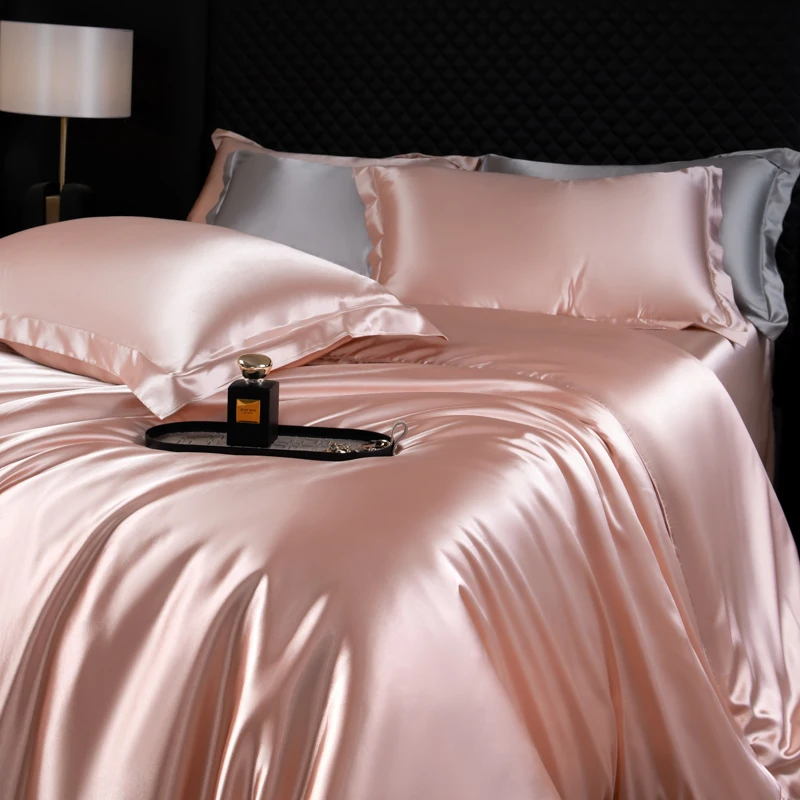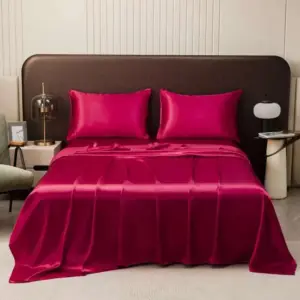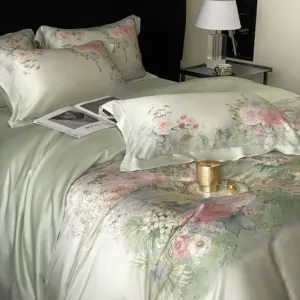Introduction: Understanding the Temperature Regulation Challenge in Sleep
Sleep quality and temperature are deeply interconnected. Too hot or too cold, and your body struggles to maintain the restful state needed for proper recovery. Many people find themselves kicking off blankets in the middle of the night, flipping pillows to find the “cool side,” or piling on extra layers only to wake up sweating.
Temperature-related sleep problems affect millions of sleepers:
- Overheating disrupts the body’s natural sleep cycle
- Night sweats can leave bedding damp and uncomfortable
- Cold sleeping environments can prevent falling asleep
- The optimal sleep temperature range is 60-67°F (15.5-19.4°C), yet many bedrooms and bedding fail to maintain this balance
This is where silk sheets offer a remarkable solution. Unlike standard bedding materials, silk provides adaptive temperature control that works with your body’s natural fluctuations throughout the night. The scientific explanation of how silk regulates temperature reveals that this isn’t just luxury marketing—it’s biology and physics working together.
Mulberry silk, considered the premium variety, offers the most effective temperature regulation properties. Its unique fiber structure creates a microclimate that adjusts to your body’s needs, whether you’re naturally hot, experiencing hormonal changes, or simply dealing with seasonal temperature shifts.
Quality sleep and temperature regulation go hand in hand, which is why premium Mulberry silk bedding sets have become the preferred choice for those seeking comfortable, uninterrupted sleep regardless of external conditions.
The Science Behind Silk’s Temperature-Regulating Properties
To understand why silk excels at temperature regulation, we need to look at its fundamental structure. Unlike cotton, polyester, or other common bedding materials, silk is a protein fiber rather than a plant-based or synthetic one. This distinction makes all the difference in how it interacts with your body during sleep.
Silk fibers are composed primarily of two proteins: fibroin and sericin. Fibroin forms the core structural component while sericin acts as a binding agent. This protein-based composition gives silk unique properties:
- Each silk fiber has a hollow core, creating microscopic air pockets throughout the fabric
- The fibers have a triangular prism-like cross-section that reflects light (creating silk’s shine) but also helps disperse heat
- The amino acid structure of silk protein allows it to interact differently with moisture than plant-based fibers
- Silk fibers can absorb up to 30% of their weight in moisture without feeling wet
The thermal properties of silk bedding are particularly remarkable. Silk has a thermal conductivity that sits in the sweet spot between materials that insulate too much (trapping heat) and those that provide no warmth. This balance allows silk to maintain a temperature differential of approximately 4-5°F (2-3°C) compared to other common bedding materials.
At a molecular level, silk’s structure allows it to:
- Create micro air pockets that trap heat when needed
- Release excess heat when temperatures rise
- Wick moisture away from the body to prevent the clammy feeling associated with sweating during sleep
- Distribute heat evenly across the surface rather than creating hot spots
These properties aren’t marketing claims—they’re the result of silk’s natural composition. Silk’s temperature regulation capabilities function without any chemical treatments or special manufacturing processes. It’s simply how silk exists in nature, making it an exceptional material for maintaining comfort throughout your sleep cycle.
Cooling Properties: How Silk Keeps You Cool in Warm Conditions
When temperatures rise, finding comfortable bedding becomes crucial for quality sleep. Silk sheets excel in warm conditions through several natural mechanisms that work together to create a cooling effect.
Silk’s superior breathability comes from its unique fiber structure. Unlike tightly woven cotton or synthetic materials that can trap air and heat, silk allows constant air circulation through its fibers. This ventilation helps dissipate body heat and prevents the buildup of warm air that causes discomfort.
The moisture-wicking properties of silk are particularly valuable during warm nights:
- Silk can absorb up to 11% of its weight in moisture without feeling damp
- Perspiration is drawn away from your skin rapidly
- The moisture spreads across the fabric surface, allowing for faster evaporation
- This process creates a natural cooling effect as the moisture evaporates
Additionally, silk has remarkably low heat retention compared to other natural fibers. When you move during sleep, silk quickly releases the heat from your previous position rather than storing it and creating uncomfortable hot spots.
Silk sheets in hot weather perform exceptionally well because they maintain a temperature several degrees cooler than cotton alternatives. This difference becomes especially noticeable during summer months or for those who naturally sleep hot.
Perhaps most impressive is silk’s adaptive quality—it doesn’t simply cool regardless of conditions. Instead, it responds to your body’s temperature and moisture output, providing cooling effects precisely when and where needed. This responsiveness makes cooling silk sheets ideal for those who struggle with overheating during sleep or experience night sweats.
Warming Properties: How Silk Provides Insulation in Cool Conditions
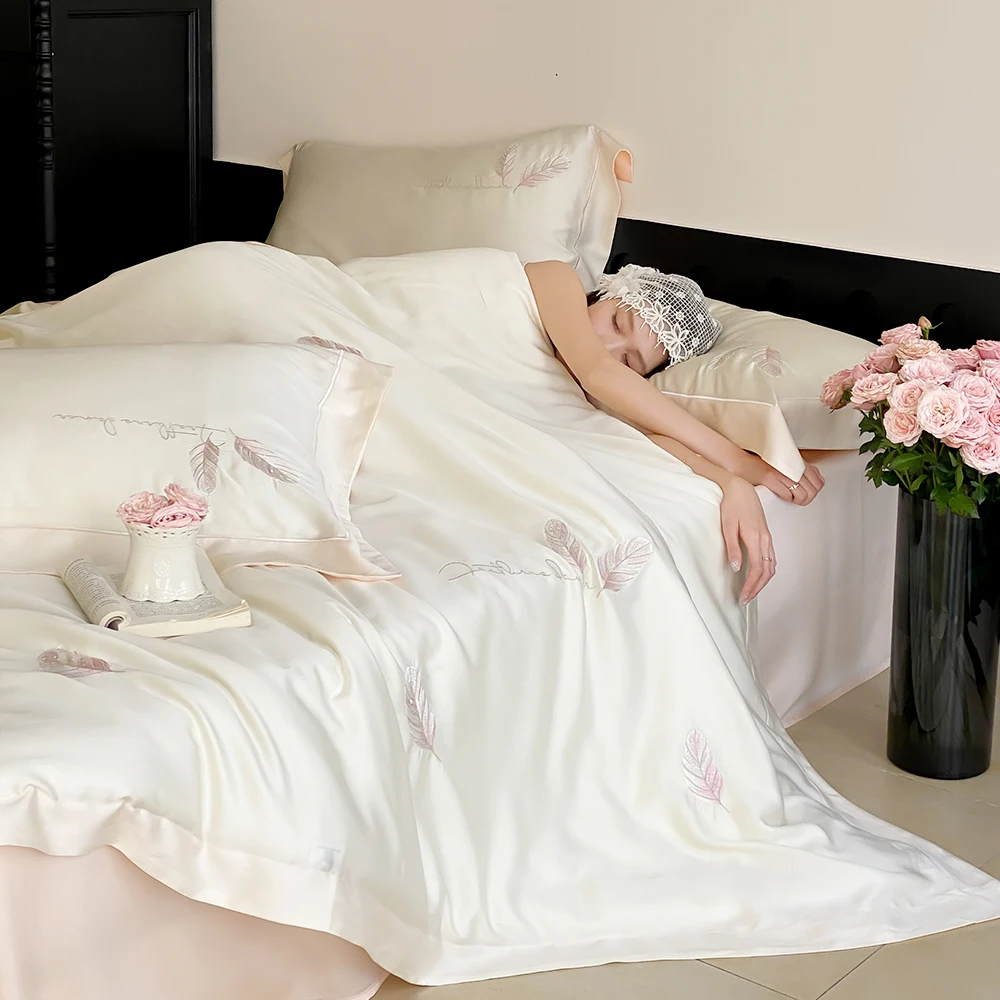
While silk excels at cooling in warm environments, it’s equally effective at providing warmth during cooler conditions—a seemingly contradictory quality that makes it uniquely valuable for year-round use.
Silk’s natural insulating properties stem from its protein-based structure. Unlike plant fibers, silk creates a layer of warmth through several mechanisms:
- The hollow core of silk fibers traps tiny pockets of air that retain body heat
- These micro air pockets form a thermal barrier between your body and the cooler external environment
- The tight weave pattern of quality silk sheets (especially in the 19-25 momme range) creates an effective insulation layer
- Heat distribution remains even, eliminating cold spots that disrupt sleep
What truly sets silk apart is its ability to provide what sleep experts call “dry warmth.” Unlike synthetic materials that can create a sweaty, stifling environment, or cotton that becomes cold when damp, silk maintains its insulating properties while continuing to wick away moisture. This combination prevents the chilly dampness that often disturbs sleep in cool conditions.
Remarkably, silk provides this warmth without weight. The lightweight nature of silk bedding for both hot and cold sleepers means you get thermal protection without the heavy, restrictive feeling of traditional winter bedding. This lightness allows for better movement during sleep while still maintaining the cozy microclimate around your body.
For those seeking optimal insulation during colder months, 100% silk sheets with a higher momme weight (22-25) provide enhanced thermal protection while maintaining breathability. The natural temperature-adaptive quality means you won’t overheat even as the sheets provide insulation against cooler air.
Material Comparison: Silk vs. Other Bedding Fabrics
Understanding how silk compares to other popular bedding materials helps explain why it excels at temperature regulation. Each fabric has distinct properties that affect sleep comfort in different conditions.
| Material | Breathability | Moisture-Wicking | Insulation | Heat Retention | Year-Round Suitability |
|---|---|---|---|---|---|
| Silk | Excellent | Excellent | Very Good | Low | Excellent |
| Egyptian Cotton | Good | Moderate | Moderate | Moderate | Good |
| Standard Cotton | Moderate | Moderate | Low | Moderate | Moderate |
| Linen | Very Good | Good | Poor | Very Low | Good (seasonal) |
| Bamboo/Rayon | Good | Very Good | Low | Low | Good |
| Microfiber/Polyester | Poor | Poor | Good | High | Poor |
| Tencel/Lyocell | Good | Very Good | Low | Low | Good |
Silk stands out with its balanced performance across all categories. While cotton offers decent breathability, it tends to retain moisture once wet, creating discomfort during hot nights or for those who perspire. Silk compared to cotton shows significant advantages in moisture management and temperature adaptability.
Linen provides excellent cooling properties in summer but offers minimal insulation for cooler conditions. It also tends to feel rough against sensitive skin and wrinkles substantially, requiring more maintenance.
Bamboo and Tencel fabrics have gained popularity for their cooling properties, but they lack silk’s insulating capabilities in cooler conditions. Additionally, most bamboo fabrics are actually rayon (a chemically processed material), lacking the natural protein structure that gives silk its thermal-regulating properties.
Synthetic materials like microfiber and polyester trap heat and moisture, creating an uncomfortable sleep environment despite their affordability. While they provide warmth in winter, they become stifling in warmer conditions.
For those seeking silk’s benefits but preferring plant-based options, vegan silk alternatives are available that mimic some of silk’s temperature-regulating qualities, though they typically can’t match the full range of natural silk’s adaptive properties.
Who Benefits Most: Ideal Sleep Scenarios for Silk Sheets
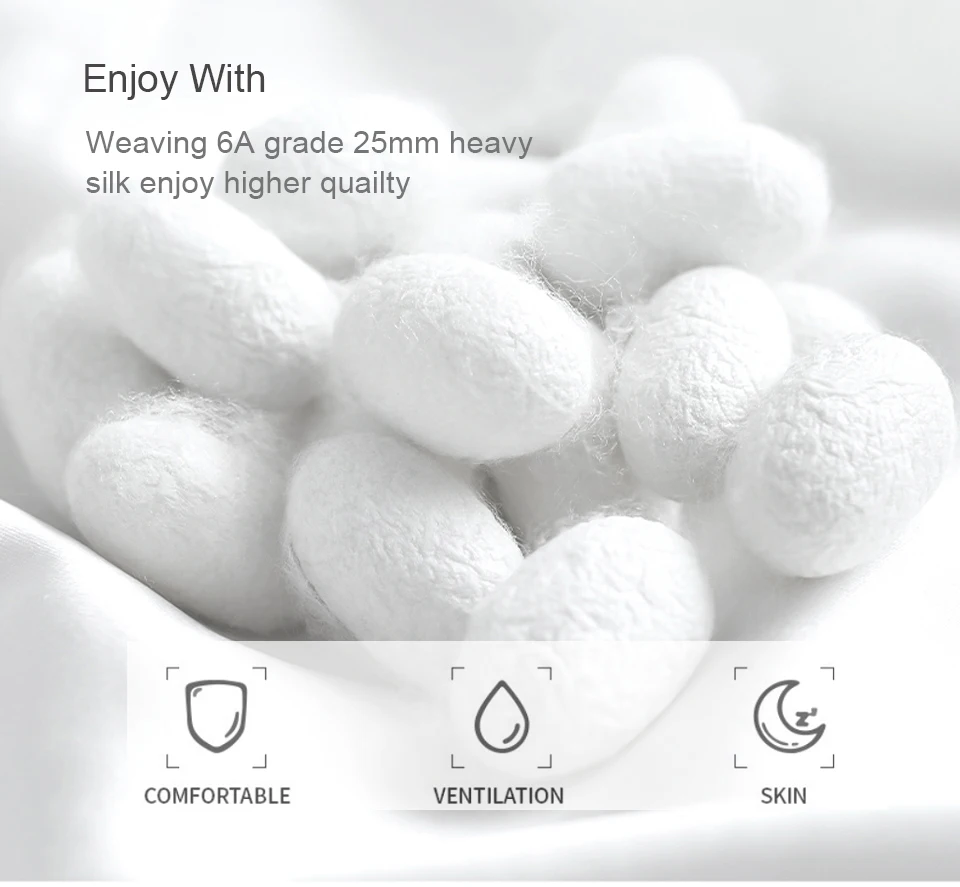
Silk sheets offer universal benefits, but certain sleepers will notice particularly dramatic improvements in their sleep quality:
Hot Sleepers and Night Sweat Sufferers
Those who routinely overheat during sleep find that silk provides immediate relief. The material’s natural ability to prevent night sweats through rapid moisture absorption and evaporation helps maintain dry, comfortable sleeping conditions. Hot sleepers report fewer disruptions and more consistent sleep throughout the night.
Couples with Different Temperature Preferences
One partner runs hot while the other feels cold? Silk’s adaptive properties accommodate both simultaneously. The side-by-side thermal regulation means each sleeper experiences their optimal temperature without compromising their partner’s comfort—a remarkable solution for couples who previously struggled with bedding choices.
Variable Climate Dwellers
People living in regions with significant seasonal changes or day-to-night temperature fluctuations benefit from silk’s year-round adaptability. Rather than switching between summer and winter bedding, silk provides consistent comfort across temperatures ranging from 60-85°F (15.5-29.4°C).
Those with Temperature-Sensitive Medical Conditions
Conditions like multiple sclerosis, fibromyalgia, and certain thyroid disorders often involve temperature regulation challenges. Silk’s adaptive properties help maintain the narrow comfort range many of these individuals require for restorative sleep.
Menopausal Women
Women experiencing hot flashes and night sweats during menopause report significant improvement with silk bedding. The immediate moisture-wicking and cooling properties provide relief during episodes, while maintaining comfortable warmth between them.
Sensitive Skin Sufferers
Beyond temperature regulation, those with eczema, dermatitis, or general skin sensitivities benefit from silk’s smooth surface and hypoallergenic properties, which reduce irritation while maintaining ideal sleeping temperatures.
The common thread among all these sleepers is the need for adaptive bedding that responds to changing body conditions throughout the night—precisely what makes silk uniquely valuable for so many different sleep scenarios.
The Momme Weight Factor: Impact on Temperature Regulation
When shopping for silk sheets, you’ll encounter the term “momme weight”—a measurement of silk density that significantly affects temperature regulation performance.
Momme (pronounced “moe-mee”) measures the weight of silk in pounds per 100 yards of fabric that is 45 inches wide. Higher momme counts indicate denser, more durable silk with distinct temperature-regulating properties:
Lightweight Silk (12-16 momme)
– Provides maximum cooling effect
– Highly breathable with excellent air circulation
– Ideal for very hot sleepers or warm climates
– Less durable than heavier options
– Offers limited insulation in cooler conditions
Medium Silk (17-19 momme)
– Balanced temperature regulation properties
– Good moisture-wicking with moderate insulation
– Suitable for year-round use in most climates
– Durable enough for regular use
– The “Goldilocks” choice for many sleepers
Heavy Silk (22-25 momme)
– Enhanced insulation properties
– Maintains breathability despite denser weave
– Excellent for cooler environments while still preventing overheating
– Superior durability and longevity
– Premium feel with substantial drape
Understanding silk momme weight helps you select sheets that match your specific temperature regulation needs. Most experts recommend 19-22 momme as the ideal balance for temperature regulation, offering sufficient density for durability while maintaining optimal breathability.
It’s worth noting that momme weight directly impacts quality and performance. Ultra-light silk (below 12 momme) typically lacks durability, while extremely heavy silk (above 30 momme) may sacrifice some breathability. The sweet spot for temperature regulation lies in that 19-25 momme range that Sanctuary Soft specializes in, providing the perfect balance between cooling properties, insulation, and longevity.
Beyond Temperature: Additional Benefits of Silk Bedding
While temperature regulation may be your primary motivation for considering silk sheets, these luxurious bedding options offer numerous additional benefits:
Hypoallergenic Properties
Silk’s protein structure naturally resists common allergens that plague many sleepers. The hypoallergenic qualities of silk fabric include:
– Natural resistance to dust mites (which cannot easily grip silk’s smooth surface)
– Inhospitable environment for mold and mildew development
– Reduced bacterial growth (approximately 30% less than cotton)
– Minimal allergen retention compared to other fabrics
Skin and Hair Benefits
The smooth surface of silk (measuring just 1.0-1.5 denier compared to cotton’s coarser texture) creates less friction against skin and hair:
– Reduced facial creasing and wrinkles while sleeping
– Less hair breakage and tangling overnight
– Preservation of natural skin moisture
– Gentler environment for sensitive or acne-prone skin
Durability and Long-Term Value
Quality silk bedding represents an investment that pays dividends over time:
– Premium silk sheets can last 10+ years with proper care
– Resistance to pilling and thinning common in other fabrics
– Color retention superior to many cotton alternatives
– Maintains temperature-regulating properties throughout its lifespan
Reduced Static Electricity
Silk generates minimal static electricity compared to synthetic materials:
– Less clinging and discomfort
– Reduced attraction of dust particles
– More comfortable sleep environment, especially in dry conditions
Eco-Friendly Aspects
Natural silk offers environmental benefits:
– Biodegradable material that eventually returns to the earth
– Requires less water in production than cotton
– Durable nature means less frequent replacement
These additional benefits complement silk’s temperature-regulating properties, creating a comprehensive sleep solution. Silk pillowcases offer a more accessible entry point for experiencing these benefits, particularly the skin and hair advantages, before investing in complete sheet sets.
Full-size Silk Sheets, King Size Silk Sheets, Queen Size Silk Sheets, Twin Size Silk Sheets, Washable Silk Sheets
Price range: $95.95 through $178.37 Select options This product has multiple variants. The options may be chosen on the product page100% Silk Sheets, Green Silk Sheets, King Size Silk Bedding Set, Mulberry Silk Bedding Sets, Queen Size Silk Bedding Set
Price range: $1,246.21 through $1,615.22 Select options This product has multiple variants. The options may be chosen on the product pageEucalyptus Silk Bedding Sets, Eucalyptus Silk Sheets
Price range: $360.24 through $393.60 Select options This product has multiple variants. The options may be chosen on the product pagePink Silk Sheets, Twin Size Silk Sheets
$171.80 Select options This product has multiple variants. The options may be chosen on the product pageFull-size Silk Sheets, Pink Silk Sheets
$136.31 Select options This product has multiple variants. The options may be chosen on the product pageGrey Silk Sheets, Silk Sheet and Pillowcase Set
Price range: $88.20 through $146.64 Select options This product has multiple variants. The options may be chosen on the product page
Caring for Silk Sheets to Maintain Temperature-Regulating Properties

To ensure your silk sheets maintain their temperature-regulating abilities over time, proper care is essential. The good news is that silk maintenance is simpler than many believe.
Washing Guidelines
– Use cold water only (below 86°F/30°C)
– Select the delicate cycle on your washing machine
– Use pH-neutral detergent specifically formulated for silk or delicates
– Avoid bleach, fabric softeners, and enzyme-containing detergents
– Turn sheets inside-out before washing to reduce friction
– Place inside a mesh laundry bag for extra protection
Drying Methods
– Air-drying is strongly preferred to maintain fiber integrity
– Hang sheets or lay flat away from direct sunlight
– If using a dryer, select air-only setting with no heat
– Remove promptly when slightly damp and allow to finish air-drying
– Never wring or twist silk when wet as this damages fibers
Storage Recommendations
– Store in breathable cotton bags, never in plastic
– Place in a cool, dry location away from direct sunlight
– Add cedar blocks rather than mothballs to deter pests
– Ensure sheets are completely dry before storing
– Avoid folding in the same creases repeatedly
Common Mistakes That Damage Temperature-Regulating Properties
– Using hot water (destroys protein fibers)
– Applying direct heat from irons or dryers (breaks down fiber structure)
– Using standard detergents (residues impact moisture-wicking)
– Exposing to prolonged sunlight (degrades fibers and moisture management)
– Applying strong deodorants or perfumes before sleep (can damage fibers)
Signs It’s Time to Replace Your Silk Sheets
– Visible thinning in high-contact areas
– Significantly reduced sheen even after washing
– Persistent odors that washing doesn’t remove
– Noticeable decrease in temperature regulation performance
– Development of tears or splits in the fabric
Following these care guidelines ensures the silk bedding care and maintenance preserves the temperature-regulating properties that make these sheets so valuable. With proper care, quality silk sheets can provide years of comfortable, temperature-regulated sleep.
Real-World Temperature Regulation Scenarios with Silk
Understanding silk’s theoretical benefits is one thing—experiencing how it performs in real-world conditions is another. Let’s explore how silk sheets handle various temperature challenges:
Summer Heat Waves
During periods of extreme heat, silk’s cooling properties become most apparent. The sheets remain cool to the touch even when room temperatures climb above 80°F (27°C). The rapid moisture-wicking prevents the clammy feeling common with cotton sheets, allowing continuous airflow against the skin. Users report maintaining sleep even during 90°F+ (32°C+) nights when using silk, particularly when regulating sleep temperature with silk becomes crucial for rest.
Winter Cold Snaps
In frigid conditions, silk’s insulating properties create a warm microclimate without the weight of heavy blankets. Within minutes of getting into bed, the space between silk sheets warms to a comfortable temperature and maintains it throughout the night. The insulation works even in poorly heated rooms or during power outages, providing critical warmth when needed most.
Transitional Seasons
Spring and fall present unique challenges with fluctuating temperatures. Silk adapts hour by hour—cooling during warmer evenings and providing insulation as temperatures drop toward dawn. This adaptability eliminates the common problem of going to bed comfortable but waking up either sweating or shivering as conditions change.
Humidity Considerations
In humid environments, silk’s moisture-wicking properties prevent the sticky, suffocating feeling common with cotton and synthetic sheets. Even in 70%+ humidity, silk maintains a relatively dry feel against the skin. Conversely, in extremely dry conditions, silk helps maintain skin hydration while still allowing proper airflow.
Air-Conditioned Environments
For those sleeping with air conditioning, silk prevents the over-cooling common with other sheets. The insulating layer moderates the impact of cool air while still maintaining breathability, creating a consistent sleeping temperature despite fluctuations in HVAC output throughout the night.
These real-world scenarios demonstrate why silk’s temperature control properties make it uniquely suited for year-round use regardless of climate or environmental conditions.
Common Misconceptions About Silk and Temperature Regulation
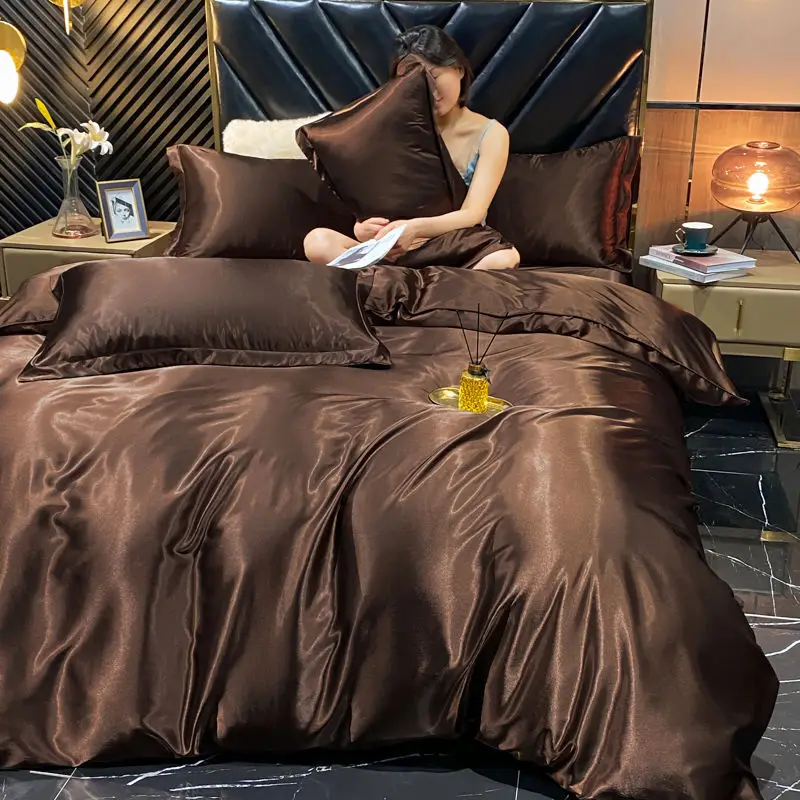
Despite silk’s long history as a premium bedding material, several misconceptions persist about its temperature-regulating abilities:
Myth: “Silk is only good for summer/cooling.”
Fact: While silk excels at cooling, its insulating properties make it equally valuable in winter. The protein structure of silk fibers creates natural insulation that traps body heat when temperatures drop, while still allowing excess heat to escape when necessary.
Myth: “All silk sheets perform the same.”
Fact: Silk quality varies dramatically based on type (Mulberry vs. Tussah), momme weight, and production methods. Budget silk often contains fillers or lower-quality fibers that compromise temperature regulation. Premium silk like that used in Sanctuary Soft products maintains consistent temperature control properties.
Myth: “Silk is always cold to the touch.”
Fact: While silk initially feels cool against the skin, it rapidly adjusts to body temperature. This adaptive quality means it feels cool when you’re hot but warm when you’re cold—a property known as thermal equilibrium that few other fabrics possess.
Myth: “Synthetic ‘silk’ offers the same benefits.”
Fact: Artificial silks (polyester satin, nylon, etc.) lack the protein structure and hollow fiber core that give real silk its temperature-regulating properties. These synthetic alternatives often trap heat and moisture, creating sleep discomfort rather than alleviating it.
Myth: “Higher thread count means better temperature regulation.”
Fact: For silk, momme weight—not thread count—determines quality and performance. Thread count marketing often misleads consumers, as ultra-high thread counts can actually decrease breathability in many fabrics. Silk’s natural structure provides temperature regulation regardless of thread count metrics.
Myth: “Silk sheets are too delicate for regular use.”
Fact: Quality silk (19-25 momme) is surprisingly durable and becomes stronger when wet, unlike many fabrics. With proper care, silk bedding maintains its temperature-regulating properties for many years of regular use.
Understanding these facts helps consumers make informed decisions when investing in temperature-regulating bedding, avoiding marketing claims that don’t align with the scientific properties of genuine silk.
How to Select Silk Sheets for Optimal Temperature Regulation
Choosing the right silk sheets for your temperature regulation needs involves several key considerations:
Silk Type Matters
– Mulberry silk: The highest quality option with the best temperature regulation (from silkworms fed exclusively on mulberry leaves)
– Tussah silk: Wild silk with slightly less consistent temperature regulation but more textured appearance
– Habotai silk: Lighter weight with excellent cooling but less insulation
– Charmeuse silk: Good balance of temperature properties with a glossier finish
Momme Weight Selection
– For maximum cooling: 16-19 momme
– For year-round versatility: 19-22 momme
– For balanced cooling and insulation: 22-25 momme
– For maximum insulation while maintaining breathability: 25+ momme
Weave Considerations
– Charmeuse weave: Excellent temperature regulation with classic silk feel
– Habotai weave: Maximum breathability for hot climates
– Crepe weave: Slightly more textured with good moisture management
– Satin weave: Smoother finish with good insulation properties
Pure Silk vs. Blends
– 100% silk provides optimal temperature regulation
– Silk-cotton blends offer easier care but reduced temperature benefits
– Silk-bamboo blends combine cooling properties but may sacrifice insulation
Certification Checklist
– OEKO-TEX certification ensures no harmful substances that might affect performance
– Look for specific momme weight guarantees rather than vague “heavy silk” claims
– Authentic silk will always specify exact momme weight and silk type
When evaluating temperature-regulating silk sheets, ask retailers specific questions:
– What is the exact momme weight?
– Is this 100% silk or a blend?
– What type of silk is used (Mulberry, Tussah, etc.)?
– How should the sheets be washed to maintain temperature-regulating properties?
– What is the expected lifespan with proper care?
For those seeking the highest quality options, premium mulberry silk sheets offer the most consistent temperature regulation, with the 19-25 momme range providing the optimal balance between cooling, insulation, and durability.
Frequently Asked Questions About Silk and Temperature Regulation

Do silk sheets make you sweat?
No, silk sheets actually reduce sweating by wicking moisture away from the body and allowing proper airflow. Unlike synthetic materials that trap heat and moisture, silk creates a breathable environment that helps regulate body temperature and reduce perspiration.
Are silk sheets good for hot sleepers?
Yes, silk sheets are excellent for hot sleepers. The natural protein fibers of silk draw heat away from the body, while simultaneously wicking moisture to create a cooling effect. Hot sleepers typically report significant improvement in sleep quality when switching to silk.
Do silk sheets keep you warm in winter?
Yes, silk sheets provide excellent insulation in winter. The hollow core of silk fibers traps warm air close to the body while still allowing excess heat to escape, preventing overheating. This creates a comfortable microclimate that maintains warmth without the weight of heavy winter bedding.
How do silk sheets compare to bamboo for cooling?
Both silk and bamboo offer good cooling properties, but they work differently. Bamboo excels at initial cooling and moisture-wicking but lacks silk’s adaptive qualities. Silk provides better temperature balance throughout the night and offers superior insulation when temperatures drop, making it more versatile across conditions.
Are silk sheets worth the investment for temperature regulation?
For those who struggle with temperature-related sleep issues, silk sheets are definitely worth the investment. Their unique ability to both cool and insulate as needed provides consistent comfort that can significantly improve sleep quality. Additionally, properly maintained silk sheets last many years longer than cotton alternatives, providing better value over time.
How long do silk sheets maintain their temperature-regulating properties?
With proper care, high-quality silk sheets maintain their temperature-regulating properties for 7-10 years. The protein structure of silk fibers remains stable unless damaged by improper washing or exposure to harsh chemicals, allowing for long-term performance that justifies the initial investment.
Do silk sheets feel cold when you first get into bed?
Initially, silk sheets may feel cool to the touch, but they quickly warm to body temperature. This initial cooling sensation is refreshing to many users, particularly hot sleepers, while the rapid temperature adjustment ensures comfort within minutes of getting into bed.
Do silk sheets work with heated blankets or electric blankets?
Yes, silk sheets can be used with heated blankets, though care should be taken to use lower heat settings. Silk’s natural insulating properties often reduce the need for electric blankets, but when used together, they create an extremely comfortable sleeping environment for cold conditions.
For a more comprehensive overview of options, our guide to temperature-regulating sheets provides detailed comparisons across various materials and technologies.
Conclusion: Embracing Temperature-Regulated Sleep with Silk
The remarkable temperature-regulating properties of silk sheets offer a solution to one of sleep’s most persistent challenges—maintaining comfort throughout the night regardless of external conditions or personal temperature preferences.
Silk’s unique composition creates a microclimate that adapts to your body’s needs: cooling when you’re hot, insulating when you’re cold, and wicking away moisture throughout the night. This natural adaptability makes silk the ideal year-round bedding choice, eliminating the need for seasonal sheet changes or compromising between warmth and breathability.
The investment in quality silk bedding pays dividends not just in temperature regulation but also in the many additional benefits silk provides—from hypoallergenic properties that reduce allergic reactions to the gentle treatment of skin and hair that preserves your appearance over time. The durability of proper silk sheets means these benefits continue for years with minimal degradation in performance.
Sleep science continues to emphasize the critical importance of temperature regulation for achieving deep, restorative sleep phases. By maintaining the optimal sleep temperature range throughout the night, silk sheets help you achieve more consistent quality rest, which impacts everything from cognitive function to immune system strength.
Whether you struggle with night sweats, share a bed with someone who has different temperature preferences, or simply want the luxury of perfectly regulated sleep in any season, silk offers a natural solution backed by centuries of use and modern scientific understanding. Experience the difference that temperature-regulated sleep can make with the adaptive comfort that only genuine silk can provide.

